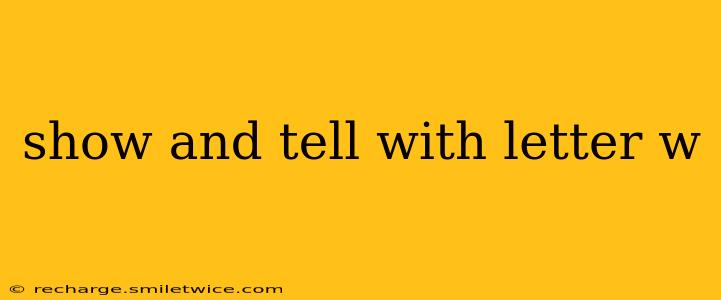Learning the alphabet can be fun and engaging, especially when we use creative methods! This post explores exciting "show and tell" activities centered around the letter W, perfect for preschoolers, kindergarteners, and early elementary students. We’ll cover various approaches to help children master letter recognition, pronunciation, and even basic word association. Let's dive in!
What Words Start with W? Brainstorming and Exploration
Before diving into elaborate activities, it's crucial to brainstorm words that start with the letter W. This foundational step helps children associate the letter with its sounds and related vocabulary. Ask them what they already know!
Activity: Start by writing a large "W" on the board or a piece of paper. Then, encourage the children to shout out words that begin with "W." Write these words down around the "W," creating a visual word web. Some examples include: water, whale, wagon, worm, window, and watch. Don't worry about perfection; the goal is participation and word recognition.
Show and Tell: Objects Starting with W
This classic activity is easily adaptable to any letter, including W! It encourages both visual recognition and verbal expression.
Activity: Ask each child to bring an object from home that starts with the letter W. This could be anything from a wagon toy to a picture of a whale. During show-and-tell time, guide them to describe their object, emphasizing the starting sound "W." For children who struggle, provide gentle assistance and visual cues. This activity fosters vocabulary development and strengthens their understanding of the letter’s sound.
Show and Tell: Pictures of Things Starting with W
Not everyone has access to physical objects, so incorporating pictures is a fantastic alternative.
Activity: Prepare a collection of pictures representing words starting with "W." These could be printed images, flashcards, or even pictures drawn by the children themselves. During show-and-tell, have each child choose a picture, describe it, and pronounce the word. The visual aid makes the activity accessible to all learning styles. Consider using various types of images: photographs, drawings, cartoon characters, etc., to cater to different preferences and learning styles.
What Does W Look Like? Sensory Exploration
Moving beyond just the auditory and visual, let's incorporate sensory elements! This helps children connect the letter W with various textures and experiences.
Activity: Use playdough or clay to create the shape of the letter W. Children can roll, shape, and manipulate the material, making the learning process tactile and engaging. Alternatively, use various materials like yarn, sticks, or even pasta to create a larger-than-life W on the floor. This kinesthetic approach enhances understanding and memorization.
Why is W Important? Real-World Applications
Demonstrating the real-world relevance of the letter W makes the learning experience more purposeful.
Activity: Discuss how often we see the letter W in everyday life. Point out words on signs, labels, books, and other objects. For instance, you could discuss the "W" in "Welcome," "Water," or even brand names. This demonstrates the practical application of letter recognition beyond the classroom.
What are some other W words? Expanding Vocabulary
Continuous learning is key! This section aims to encourage further exploration.
Activity: Introduce new words starting with "W" regularly. Use age-appropriate books, games, and songs that incorporate words beginning with "W." The more exposure children have, the more easily they'll recognize and remember the letter and its associated sounds. For older children, you could even explore words with "W" in the middle or at the end, enhancing their overall vocabulary.
By incorporating these fun and engaging activities, you can make learning the letter W a rewarding and memorable experience for young learners. Remember to keep it playful and encourage participation—the more fun it is, the more effectively they'll learn!
